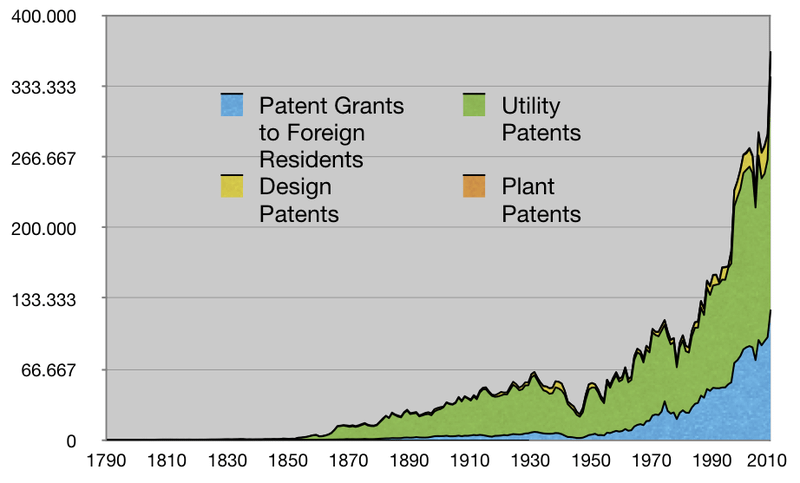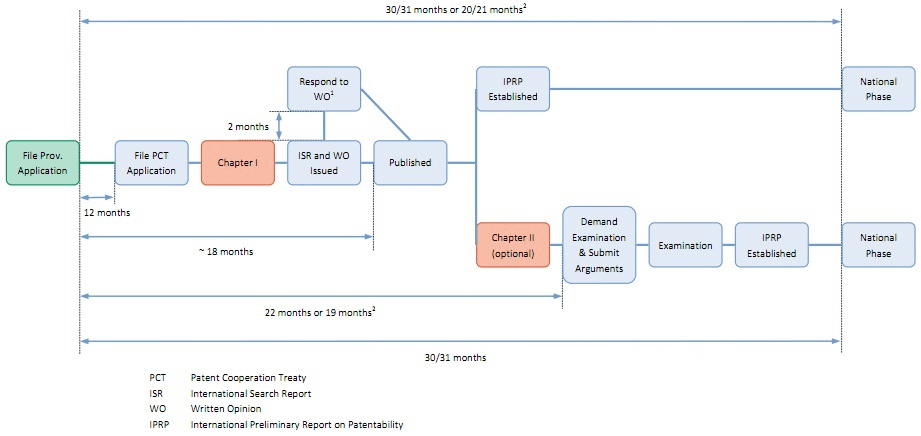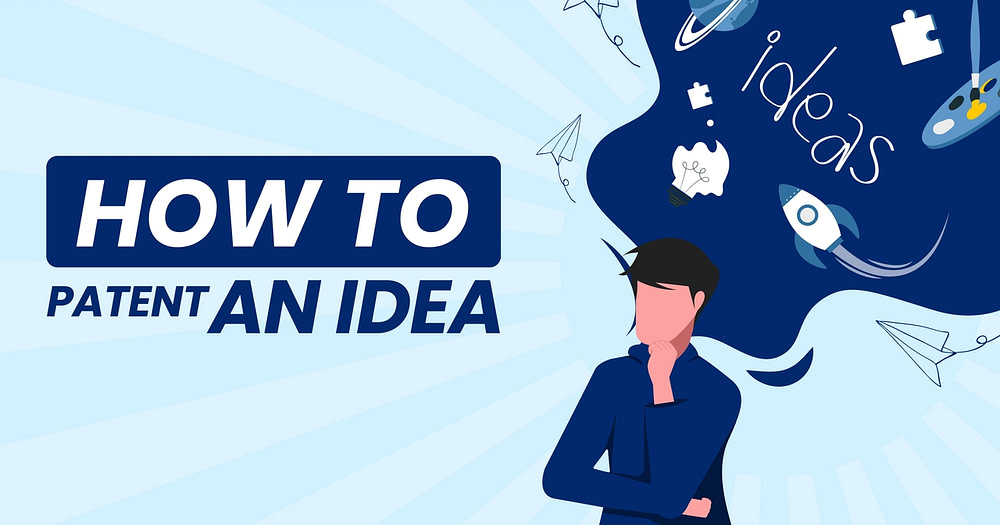Most people have a genius idea lurking within them, but most of us fail to explore it to the fullest potential.
But what’s worse is a genius idea that is developed, created, and launched without adequate protection, leaving it wide open to exploitation.
This is where a patent enters the fold – like a metaphorical big brother, protecting your ideas from plagiarism.
Obtaining one, however, takes a little effort. Anyone can apply, but there are certain steps and procedures you need to be aware of to do so successfully.
Let’s take a look at what they are.
What Is A Patent?
A patent represents any patented product or idea granted by the U.S. Patent and Trademark Office (USPTO for short) to any individual.
The idea cannot be sold if it is not used or imported. While holding a valid patent, no other company can use any of your designs. Think of it as anti-plagiarism.
The USPTO gives you exclusive rights regarding using, selling, or marketing your invention. For example, let’s say you managed to patent your new submarine design.
Any part of your design that was approved for the patent would be out of bounds for all other companies, even if they had a similar thought. They would have to make their submarine invention utterly different from yours in every way.
Now, you can’t patent a submarine and stop anyone from ever making another one again. The patent only protects your unique ideas rather than the submarine as a whole.
Let’s take a smartphone as another example. Apple released a brand new camera lens with their iPhone 14 this year. The telephoto lens they mention can zoom further than the previous lens.
They have patented this lens, meaning no other company can copy it. However, this patent doesn’t stop Samsung or any other company from continuing to produce new lenses.
It simply means they can’t make one with the same unique tech that the Apple lens has.
The same goes for processing chips. Every new smartphone processing chip has the same fundamental components that go toward making it work.
You can’t patent things like the plastic cover of the chip, but you can, however, patent any specific upgrade that was uniquely invented by your company.
Now that we have an idea of what a patent is let’s take a look at the main types of patents available.
4 Types Of U.S.-Based Patents
The type and availability of patents vary depending on the country you live in. For simplicity, we will look at the four types of patents available in the U.S.
1. Utility Patents

A utility patent gets issued for the invention of new and useful processes, machines, and materials and for new and useful improvements of such processes. Utility patents protect their holders’ rights for 20 years.
We will focus on utility patents for this guide. Our goal is to explain how to get a patent on an idea for your startup. A utility patent is what you would need to accomplish this goal
2. Design Patents
Design patents are issued for those who invent a new design in terms of appearance rather than use or structure. If you designed a new watch, a design patent protects what the watch looks like rather than the mechanisms that make it function.
3. Plant Patents
Plant patents exist to protect any newly discovered plant variety that was created through asexual reproduction.
4. Software Patents
A software patent protects your newly invented piece of software from being used by competitors.
How To Patent An Idea

We’ll give a more detailed description of how to patent an idea later in this guide. For now, take a look at some of the basic steps to patent your idea successfully:
- Keep a journal of your journey from idea to action. The more detailed your journal, the better chance you have of getting all details patented. Each and every unique part of your idea needs to be included.
- Find out whether the invention may qualify for a patent if established patent legislation applies. Patent law may only accommodate some ideas, so you must ensure your idea qualifies. Applying for a patent when you don’t qualify will only increase the risk that someone copies your idea.
- Invent your prototype for a patent application. You don’t need a complete, perfect creation, but your prototype must accomplish your intended goal and include all the unique features you intend to protect. Visual confirmation of your idea drastically improves the chances of gaining intellectual property protection.
- Prepare the patent applications and know the costs and patent types to enhance the potential for a provisional patent. It would be best if you had everything in order to be confident that your patent will push through.
- File the provisional patent application and await your patent pending status to be considered. Consider hiring a patent attorney before the patent filing process to improve your chances. The added costs are between $1000 to $1500 for this patent attorney service, bringing your possible total costs over $10000.
Why Do We Need Patents?

Patent protection protects the value of ideas and prevents your competitors from using them. The aim is to help innovators sell their inventions with a minimum risk of getting copied.
Why do we need patents? Consider Elisha Gray’s invention for the transmission of speech via an electrical device, now known as the telephone. He pondered his work for some time, not taking full care to keep his invention from prying eyes.
As his lawyer attempted to apply for a patent, they discovered Graham Bell had just submitted the exact same idea; Elisha’s idea. Graham won the patent, leaving Elisha unable to even produce his own invention without risking a lawsuit.
Apply for a patent as early as you can, balancing the time spent researching and creating the prototype with the need to get the patent first.
Most importantly, keep your idea to yourself for as long as possible. If you really believe you have a unique, winning idea, don’t broadcast that fact to anyone who does not need to know about it. Tell no one short of your patent lawyer.
The Investment Needed To Patent An Idea: Step-By-Step Guide

Getting patents is expensive, depending on how complex your idea is. You will soon discover you have to develop prototypes to protect them.
We already touched on some basic steps earlier in the guide.
We’ll take some more developed steps to help guide you through everything you need to get your patent sorted out as quickly and efficiently as possible. Now, let’s really get into the meat of what you need.
Usually, the U.S. requires 18 or 24 months for an American patent application to be granted. It will ideally require a total of between $10k and $25k.
We highly recommend ensuring you save up for the highest possible cost or hiring a patent attorney who can tell you how much you need before you get started.
Let’s take a look at the significant steps involved in preparing for your provisional patent application:
Step 1 – Verify The Idea Is Eligible For A Patent
Before proceeding with such a complex process, you must ensure your invention is eligible for patents. Not everyone is entitled to a patent, so it is essential to determine the trademark requirements at USPTO.
If your idea meets the criteria, you can start by determining what kind of patent you want. We’ve already explained the four types available above, but you likely need a utility or software patent for a startup. Make sure to check the criteria for each type, just in case.
The final stage in testing if your idea has any merit involves an examination of the patent application.
If you believe your idea is eligible and you’ve determined the patent type needed, checking the provisional patent application requirements helps determine if you’re ready to proceed.
If you find you have the capability to fill in all of these requirements, you can proceed.
Step 2 – Keep A Detailed Record Of Everything
The invention alone does not qualify as patentable but requires proof that the concept is yours entirely. You need to write down the whole thought process, whether you prefer to do things in your head or not.
Record everything from a simple note, sketch, correction, or anything that could be helpful in convincing others that you were the creator of this idea. You need to include all notes regarding issues and fixes as well.
All prototypes run into issues, and it actually benefits you to show how easily or intelligently you overcame said problems. All notes must have their own signature and date.
You have to be extremely thorough with all of your notes and recordings. Making a single mistake or using inaccurate records may land you in a heap of trouble down the track.
Even if you manage to get your idea patented, this inaccurate data could be reason enough to rescind the patent, leaving you open for copycats.
Step 3 – Make A Prototype
You must prepare your prototypes for patent applications before submitting the documents. The prototype should be tangible and functional for use in a demonstration.
A company’s idea can have many different uses and needs. Making prototypes can help you to develop your ideas and fulfill other requirements needed to obtain a utility patent.
If the idea is brought into existence, it can help identify weaknesses and areas to improve on that you hadn’t thought of beforehand.
As you design each prototype, make sure to continue taking detailed notes. Even if you scrap the first prototype, you must still include it in your notes.
Use sketches of each step involved in the construction process for every single prototype. The more detail, the better!
Don’t worry about aesthetic features at this point, but rather stick out the unique, functional parts of your idea.
As long as it works and does whatever you designed it to do, it doesn’t matter if it is a bit skeletal in appearance. Once you have secured your patent, you can begin crafting the final product.
Step 4 – Hire A Patent Attorney
In the case of a utility or software patent, you always need a lawyer. You can choose to apply on your own, but if your application gets denied by the USPTO, then there’ll be a two-year wait until you can apply again.
During these two years, someone could easily obtain your idea and apply to patent it before you get a second chance.
A patent lawyer can help ensure your idea’s patentability. An attorney can assist in making your provisional patent application bulletproof. Let’s plot out the advantages of hiring a patent attorney:
- You gain the extra knowledge patent attorneys provide.
- Your chances of getting through the process without error are greatly improved.
- Your lawyer does most of the work for you, leaving you with plenty of time to focus on your software startup plans.
Overall, you may feel confident applying without a lawyer, which is entirely your choice. However, an approximate fee of $1000 seems a pittance in comparison to the benefits gained from spending it.
Step 5 – Apply For A Provisional Patent
Upon filing the provisional patent application, you will have the right to protect your invention for one year or until the application is approved, blocking other people from acquiring the rights of your concept.
Once your application is sitting in patent pending, your job isn’t over. Spend this waiting time working on your invention and the improvement thereof.
Once you have acquired the utility or software patent, you’ll be more than ready to go straight into putting your startup into action.
The Filing Process
When it comes to filing your patent application, you must be aware of the entire filing process. There are a considerable number of documents to put together, so make sure you know each and every one of them.
If you want to file for a nonprovisional patent, the USPTO has an extensive list of things to help you along the way. We’re going to focus on the provisional patent applications simply because they come before the nonprovisional patent application.
The provisional patent application process takes a bit more effort than a nonprovisional one, but you do get the 12 months patent pending advantage. We’ll get more into that in the next section.
The patent process takes quite a while and requires you to fill out this form in full. You also need to pay a filing fee as well as provide a cover sheet with the following information:
- The application of your idea
- Your name and the names of any other co-inventors
- Your residence
- The title or name of your invention
- The name and registration number for your patent attorney if you hired one
- A correspondence address if different from your residential address
- Any U.S. Government agency that might be interested in the application of your invention
Once you have put these documents together, you’ll be ready to file the patent application. You can use any of the following methods:
Electronically Using EFS-Web
EFS-Web allows you to file everything electronically rather than relying on hard copies in the mail. You must prepare all of your files in PDF format and pay all fees through an online portal.
Using the electronic system makes it easier to keep track of your files, as they upload directly to USPTO’s information system when you do so. They and you will be able to retrieve and view those uploaded files whenever you need to.
By Mail
If you prefer sending your information through the mail rather than electronically, you can send your printed files to this address:
Commissioner for Patents
P.O. Box 1450
Alexandria, VA 22313-1450
You need to include all of your files and the same cover sheet mentioned above, as well as cash to pay for your application.
You can call USPTO at 800-786-9199 to inquire how much the fee might be or ask your patent lawyer if you chose to hire one. Make sure the cash or cheque is payable to the ‘Director of the U.S. Patent and Trademark Office.’
Filing your patent application through the mail means that USPTO will have a tangible version of your files. However, you have the disadvantage of not keeping those files directly on their website for easy access.
You, of course, will still have your files saved electronically to your own computer, but that won’t allow you to see if USPTO has updated anything on their website instantly.
That said, they will still keep in touch with you during the process when any significant change occurs, whether you are accepted, denied, or they need further information.
Benefits And Features Of The Provisional Patent Application
Why is the provisional patent the most effective means at gaining and maintaining complete ownership of your ideas? Let’s look at some of the major benefits and features that one provides:
- It allows you to immediately start marketing and promoting your idea without the risk of anyone copying it.
- You are provided 12 months of protection. Your application will immediately enter the stage ‘patent pending.’
- You establish an exact U.S. filing date for your invention which can be used in court should anyone attempt to plagiarize the idea.
- Allows you to acquire authentic copies that are authorized by USPTO.
- Provides a cheaper means to get your application started, as the 12-month provisional patent application process costs much less than the nonprovisional patent application.
Patent Pending

During the 12-month patent pending period, you can begin commercializing your invention, meaning you can finally see your startup idea come to life!
You can also begin the nonprovisional patent filing process, which involves providing further details regarding your software idea and gaining 20 years of patent protection.
If you do not start the nonprovisional patent application within the 12-month patent pending period, your idea will no longer be protected, and any of your competitors could steal your idea and apply for a patent themselves.
If they tried the same thing during your 12-month patent pending period, it would be considered patent infringement, giving you due cause to take them to court over that particular infraction.
Why You Need To Apply For A Nonprovisional Patent ASAP
You can’t reapply for a second 12 months of protection, so it is essential that you save up and apply for your nonprovisional patent application as quickly as possible.
A nonprovisional patent costs more than a provisional one, so make sure you look into the possible costs ahead of time. In case you missed it, here’s the list of things you’ll need for your nonprovisional patent application.
How Much Does It Cost To Patent An Idea?
Utility or software patent costs are difficult to estimate as there are many different factors that could cause the costs to go up. It is important that you know approximately how much your patent may end up costing.
The general estimate for a utility patent is between $15,000 and $45,000. If your goal is to acquire a software patent, you can expect costs between $6,000 to $12,000. These are the main factors that cause such a wide estimate:
- The complexity of your invention changes how much USPTO will charge overall.
- You may choose to hire an attorney or not.
- Your initial application might get disputed (for example, if USPTO requires further information that you failed to submit initially or if they find inaccurate information in your notes and need them checked/corrected), in which case you would need to pay an additional $1,000 to $3,000 to extend the application time and correct any errors that cause this rejection.
USPTO also holds many different fees that need to be paid during the application process:
- Patent application filing process fees
- Patent search fees
- Patent examiner
- Patent issue and publication
- Extension of time
- Patent maintenance
- Post issuance
- Patent trial and appeal
- Patent petition
- Patent service
- Patent enrollment
- Miscellaneous
While not every idea will cost the same and not every fee will apply to your application, you still need to be aware of how much it could cost.
The worst thing that could happen at this point would be to get partway through setting up your startup only to run out of money and lose your chance at getting the actual patent.

Additional Tips And Tricks To Further Your Chances At Acquiring A Utility Or Software Patent
Understand Your Invention
Before attempting to gain a utility or software patent, try to understand the concept of your invention, such as the reasons why it is unique.
Suppose you created an elaborate set of shears for cutting very thin layers. The cutters have special-designed handles with different finger loop shapes as well as additional pivots to help cutters feel the slightest resistance when cutting a very thin cloth.
When you determine which aspects of your invention are unique, you will look at its broader implications. What exactly do your shears do that others don’t? What part of the design is so different that you might be able to patent it?
You need to convince USPTO that your invention is both unique and useful, which is much easier to do if you know your startup idea inside and out.
The Cons Of Applying For A Patent
The patent application process involves complexities and risks. Patent applications can become a long-running problem. There are a large number of costs, and it may take years to finish. In many instances, your invention does not require a patent.
You may also find that identifying yourself with good customer service will give you better results than patenting a utility product.
Make sure you check with an experienced patent attorney whether it is worth patenting your idea or not. If it’s just an idea that fits too closely with other inventions, your chances of getting a united states patent are slim.
Conclusively, the major con of applying for a patent is ending up getting rejected, causing your idea to be stolen and improved on by someone else.
So long as you’ve checked everything, saved up the necessary funds, and ensured that you have a patentable invention, you should be safe to proceed.
Research Your Invention
Patents must be unique. The rationale behind the patent application has been primarily to encourage inventors to show the public the process of making the invention.
The primary means of researching your invention is to research anything that might be similar to it for a start. It would be wise to investigate any patents issued to similar inventions to make sure you don’t step on any toes.
If you attempt to patent an idea that has already been patented, even if it isn’t 100% the same, you have a good chance of being rejected, causing a huge waste of time and money.
You must ensure the unique qualities and functions provided by your idea actually work and have never been used before under a patent.
Let’s take a completely fictionalized example, involving Apple and Samsung:
Imagine, if you will, that Apple invented and patented a new and useful improvement to the famous iPhone’s processing chip. The new feature improves the phone’s processing power by 20% more than the previous chip.
In this first scenario, we’ll say that Samsung has invented a new chip that uses the exact same features and has the exact same structure as the Apple chip.
When they try to get their chip patented, the patent is rejected because it is too similar to a chip that was already patented by someone else.
In this second scenario, Samsung has invented a processing chip that provides the same processing power as the Apple chip, but the design and features of the chip are unique.
This time, the patent gets approved because Samsung clearly made their own parts to create this chip, even if it has a similar function to the Apple chip.
Consider these scenarios when you research your startup idea. If someone has the exact same idea as you, don’t try to patent it.
However, if you have a different idea that provides similar benefits, you can still attempt to get it patented, as the idea and features are unique.
Patent Searching
Another important reason to research your invention is to avoid any issues during the patent search process of your application.
When USPTO performs patent searches, they’re essentially doing a thorough check of your invention against all other possible patented inventions.
A thorough patent search involves using keywords to find other inventions that may have a patent or any form of protection that might prohibit your invention from getting approved.
A utility or software patent protects any unique portion of that invention, both the concrete parts involved and any specific application that was covered under the patent.
Should you attempt to apply for a patent including any of these previously patented functions, your application will be rejected, forcing you to reassess and apply once again with a revised prototype that doesn’t cross paths with any other patents.
Are You Ready To Effectively Apply For Your Startup Invention Patent?
We hope this guide provided all the knowledge required to learn how to get a patent on an idea.
Take what you’ve learned and get your utility patent application into the USPTO patent office as soon as you safely can. You’ve got this!
